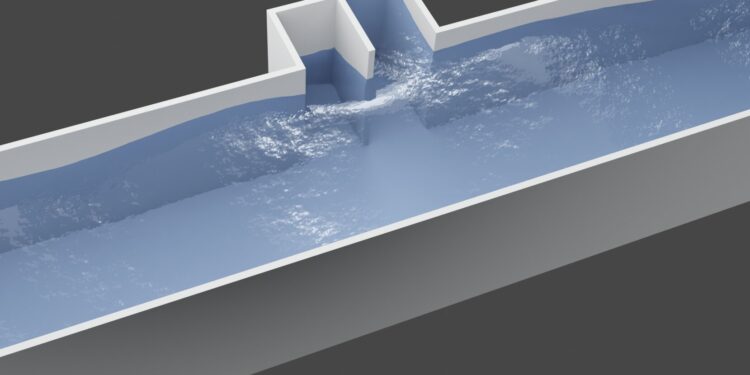Conceptual view of the wave absorption device. Credit: Léo-Paul Euvé
Water wave absorption is the process by which water waves lose their energy, thereby reducing their impact on shorelines or other solid structures around them. Enabling this absorption process in real-world settings could help protect coastlines and structures from wave damage during extreme weather conditions.
Researchers from Sorbonne Université CNRS, Institut Polytechnique de Paris, University of Bristol, Le Mans Université CNRS and Université PSL CNRS have been trying for decades to design effective strategies to enable efficient wave absorption. In a recent article published in Physical Examination Lettersthey introduced a promising new strategy, based on a concept introduced by American physicists Stanley Autler and Charles Townes in the 1950s.
“We have been working for nearly 20 years on issues related to water waves, and for around fifteen years we have focused on issues specifically related to the absorption of these waves for the protection of coasts or offshore structures. “, Agnès Maurel, co-author of the article, told Phys.org. “For this, we have developed strategies based on resonance mechanisms, as is the case in this study.”
In their paper, Maurel and colleagues presented a new strategy for achieving perfect resonant absorption of guided water waves, based on a resonance effect known as the Autler-Townes split. This is a physical effect occurring in two-level resonant systems, characterized by a splitting of two transition states into smaller “doublet” states separated by what is called a Rabi oscillation.
The Autler-Townes split has been performed and observed in various physical systems, ranging from radio frequency sources to lasers and atoms. In their study, Maurel and his colleagues attempted to exploit this well-established effect to control the propagation of guided water waves.
“This experimental achievement stems from a theoretical analysis of the resonance mechanism that we published last year and which we adapted for the specific purpose of absorbing water waves,” explained Maurel. “Léo-Paul Euvé, through his innovative approach to implementing experiments and optical measurements in the laboratory, finally succeeded in demonstrating the effectiveness of this mechanism.”
The researchers demonstrated the effectiveness of their proposed strategy for controlling water wave propagation theoretically, in numerical simulations and experimentally. In their experiments, they were able to achieve complete absorption of guided water waves, using a carefully designed asymmetric point diffuser, consisting of two closely spaced resonant side channels connected to a guide.
“The efficiency of absorption, that is, the complete suppression of waves reflected and transmitted by a sub-wavelength device, is the result that seems most significant to us,” Maurel said. “The practical applications obviously concern the design of such systems for coastal protection and, in general, for all works at sea or nearby.”
This research team’s proposed strategy for enabling resonant absorption of water waves could soon be tested further in the laboratory and in the real world. If its effectiveness is confirmed, it could ultimately be used in coastal regions, to control the energy with which waves strike surrounding shorelines and man-made structures, thereby limiting associated damage.
“In the context of applications spanning seas and oceans, it is crucial to take into account the inherently nonlinear nature and broad spectral content of waves,” added Maurel. “While we are not necessarily looking at specific applications at this time, we need to incorporate these factors into our future studies, a process that is already underway.”
More information:
Léo-Paul Euvé et al, Perfect resonant absorption of water waves guided by Autler-Townes splitting. Physical Examination Letters(2023). DOI: 10.1103/PhysRevLett.131.204002.
© 2023 Science X Network
Quote: A strategy for achieving effective resonant absorption of guided water waves (December 14, 2023) retrieved December 15, 2023 from
This document is subject to copyright. Apart from fair use for private study or research purposes, no part may be reproduced without written permission. The content is provided for information only.



